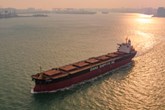Fortescue ships first magnetite product from Iron Bridge
Fortescue’s first shipment from its newly built Iron Bridge operations will soon be on its way to Vietnam, marking the first time the company has exported a high-grade magnetite product.
The shipment follows first production earlier this year, which saw the plant surpass expectations with a first run grade of greater than 67% Fe.
Iron Bridge is a demonstration of Fortescue’s pioneering innovation. It signifies the first time the company has produced a wet concentrate product, which is transported to Port Hedland through a 135 km specialist slurry pipeline where dewatering and materials handling occurs to create a high grade magnetite product.
Fortescue Metals Chief Executive Officer, Fiona Hick, joined Nyamal Traditional Custodians and representatives from Fortescue’s Iron Bridge Joint Venture partner, Formosa, in Port Hedland as the first shipment was loaded.
“Today is a truly special day for Fortescue. Last week we celebrated 20 years since Fortescue was founded, and today, we celebrate our first shipment of high-grade magnetite product from our most complex and innovative project yet.
“Iron Bridge is a game changer for Fortescue and builds on our track record of safely and successfully developing and operating iron ore projects in the Pilbara.
“High grade magnetite product will play an important role in lowering emissions in the steel industry, and Fortescue is moving at pace to ensure we are at the forefront of developing green steel technologies.
“I congratulate the entire Fortescue team for delivering this project while maintaining strong safety performance. We remain focused now on achieving a safe and efficient ramp up.”
Read the article online at: https://www.drybulkmagazine.com/dry-bulk/27072023/fortescue-ships-first-magnetite-product-from-iron-bridge/
You might also like
Diana Shipping Inc. announces time charter contracts for two dry bulkers
Diana Shipping Inc. announces time charter contracts for m/v DSI Pollux with Stone Shipping and m/v DSI Andromeda with Western Bulk.

